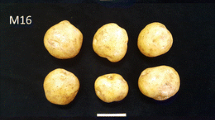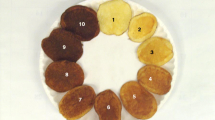Abstract
Long-term cold storage is necessary to supply potatoes to the processing industry throughout the year. Cold-induced sweetening prevents current potato cultivars from producing acceptable chips after cold storage. Resistance to cold-induced sweetening has been introgressed into the cultivated potato from wild Solanum relatives. This paper describes five tetraploid interspecific hybrid clones that can be used in breeding programs to improve chip quality in cold-stored tubers. The clones are male and female fertile, and are adapted to temperate zone production environments. All clones except M1 have low levels of glycoalkaloids. They produce acceptable chip color following storage at 4.4°C for 3 months. Tubers from all clones have high specific gravity. Following cold storage, tuber glucose and fructose contents are low compared to standard cultivars. Tuber sucrose contents for the five clones are either comparable to that in standard cultivars or much greater.
Resumen
El almacenamiento en frío a largo plazo es necesario para proveer papas a la industria del procesamiento durante todo el año. El endulzamiento inducido por el frío evita que las variedades actuales de papa produzcan papas fritas aceptables después del almacenamiento en frío. La resistencia al endulzamiento por frío se ha introducido a la papa cultivada de parientes silvestres de Solanum. Este artículo describe cinco clones híbridos tetraploides interespecíficos que pueden usarse en programas de mejoramiento genético para mejorar la calidad de fritura en tubérculos almacenados en frío. Los clones son fértiles como macho o hembra, y se adaptan a ambientes de producción de zonas templadas. Todos los clones, excepto M1, tienen bajos niveles de glicoalcaloides. Producen color aceptable de hojuela después de un almacenamiento a 4.4°C por tres meses. Los tubérculos de todos los clones tienen alta gravedad específica. Después del almacenamiento en frío, los contenidos de glucosa y fructosa de los tubérculos son bajos comparados con las variedades estándar. El contenido de sacarosa del tubérculo en los cinco clones es comparable o mayor al de las variedades estándar.


Similar content being viewed by others
References
Anonymous. 2009. Potatoes 2008 summary. Agricultural Statistics Board. National Agricultural Statistics Service. Beltsville: USDA.
Bethke, P.C., and J.C. Busse. 2008. Validation of a simple, colorimetric, microplate assay using amplex red for the determination of glucose and sucrose in potato tubers and other vegetables. American Journal of Potato Research 85: 414–421.
Bhaskar, P.B., L. Wu, J.S. Busse, B.R. Whitty, A.J. Hamernik, S.H. Jansky, C.R. Buell, P.C. Bethke, and J. Jiang. 2010. Suppression of the vacuolar invertase gene prevents cold-induced sweetening in potato. Plant Physiology 154: 939–948.
Blenkinsop, R.W., R.Y. Yada, and A.G. Marangoni. 2004. Metabolic control of low-temperature sweetening in potato tubers during postharvest storage. Horticultural Reviews 30: 317–354.
Denny, F.E., and N.C. Thornton. 1940. Factors for color in the production of potato chips. Contributions from the Boyce Thompson Institute 11: 291–302.
Denny, F.E., and N.C. Thornton. 1941. Potato varieties: Sugar forming characteristics of tubers in cold storage and suitability for production of potato chips. Contributions from the Boyce Thompson Institute 12: 217–225.
Gould, W.A., F. Hair, and A. Baroudi. 1979. Evaluation of potato cultivars before and after storage regimes for chipping. American Potato Journal 56: 133–144.
Groza, H.I., B.D. Bowen, W.R. Stevenson, J.R. Sowokinos, M.T. Glynn, C. Thill, S.J. Peloquin, A.J. Bussan, and J. Jiang. 2006. White Pearl - A chipping potato variety with high level of resistance to cold sweetening. American Journal of Potato Research 83: 259–267.
Habib, A.T., and H.D. Brown. 1957. Role of reducing sugars and amino acids in the browning of potato chips. Food Technology 11: 58–59.
Hall, R.L. 1992. Toxicological burdens and the shifting burden of toxicology. Food Technology 46: 109–112.
Hamernik, A.J., R.E.Jr. Hanneman, and S. Jansky. 2009. Introgression of wild species germplasm with extreme resistance to cold sweetening into the cultivated potato. Crop Science 49: 529–542.
Hayes, R.J., and C.A. Thill. 2002. Selection for cold chipping genotypes from three early generations in a potato breeding program. Euphytica 128: 353–362.
Hayes, R.J., and C.A. Thill. 2003. Genetic gain from early generation selection for cold chipping genotypes in potato. Plant Breeding 122: 158–163.
MacKay, G.R., J. Brown, and C.J.W. Torrance. 1990. The processing potential of tubers of the cultivated potato, Solanum tuberosum L., after storage at low temperatures. Potato Research 33: 211–218.
Marks, G.E. 1954. An acetocarmine glycerol jelly for use in pollen fertility counts. Stain Technology 29: 277.
McCann, L.C., P.C. Bethke, and P.W. Simon. 2010. Extensive variation in fried chip color and tuber composition in cold-stored tubers of wild potato (Solanum) germplasm. Journal of Agriculture and Food Chemistry 58: 2368–2376.
Periera, A., S. Da, G.C.C. Tai, R.Y. Yada, R.H. Coffin, and V. Souzamachado. 1994. Potential for improvement by selection for reducing sugar content after cold storage for three potato populations. Theoretical and Applied Genetics 88: 678–684.
Sanford, L.L., R.S. Kobayahsi, K.L. Deahl, and S.L. SInden. 1996. Segregation of leptines and other glycoalkaloids in Solanum tuberosum (4x) x S. chacoense (4x) crosses. American Potato Journal 73: 21–33.
Sinden, S.L., and R.E. Webb. 1974. Effect of environment on glycoalkaloid content of six potato varieties at 39 locations. In USDA-ARS Technical Bulletin, Vol. 1472.
Sinden, S.L., K.L. Deahl, and B.B. Aulenbach. 1976. Effect of glycoalkaloids and phenolics on potato flavor. Journal of Food Science 41: 520–523.
Sowokinos, J.R. 2001. Biochemical and molecular control of cold-induced sweetening in potatoes. American Journal of Potato Research 78: 221–236.
Thill, C.A., and S.J. Peloquin. 1995. A breeding method for accelerated development of cold chipping clones in potato. Euphytica 84: 73–80.
Xiong, X., G.C.C. Tai, and J.E.A. Seabrook. 2002. Effectiveness of selection for quality traits during the early stage in the potato breeding population. Plant Breeding 121: 441–444.
Acknowledgements
Glycoalkaloid analyses were carried out by Brian Perkins (Univ. of Maine). Wild species germplasm was provided by the US Potato Genebank, Sturgeon Bay, Wisconsin.
Disclaimer
Reported use of brand name products does not imply an endorsement by the USDA.
Author information
Authors and Affiliations
Corresponding author
Electronic supplementary material
Below is the link to the electronic supplementary material.
Table S1
(DOCX 24 kb)
Rights and permissions
About this article
Cite this article
Jansky, S.H., Hamernik, A. & Bethke, P.C. Germplasm Release: Tetraploid Clones with Resistance to Cold-Induced Sweetening. Am. J. Pot Res 88, 218–225 (2011). https://doi.org/10.1007/s12230-011-9186-3
Published:
Issue Date:
DOI: https://doi.org/10.1007/s12230-011-9186-3




